Article and photos by Joe Mish
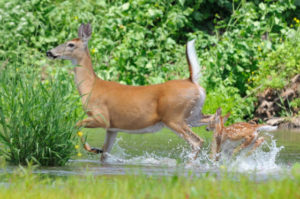
Doe and fawn kick up thie heels in the cool water of the South Branch of the Raritan.
Deer love to wade in the river, even at noon, on the hottest summer days
High Summer Drama
The low dam at Red Rock Lake turned the water of the South Branch inside out to create an unbroken white line along its length. Here, the living water falls upon itself in an act of resuscitation, no different from lifesaving CPR.
Below the dam, the freshly oxygenated water rushes to fill a deep cut in the river bed funneling its energy, impeded elsewhere by shallows and exposed tree roots.
At the start of each trip, below the lake, I do an upstream ferry across the fast water as a tribute to the river’s energy. I provide the proper angle and the river obliges with a free ride across the current with no downstream slip. Angle the bow into the opposing current and the boat spins into a downstream posture to start another river journey through the high summer season.
The water’s surface reflected the bright blue summer sky and lush greenery along the shoreline. The river banks falsely declaring a limit to the infinite reach of the sky.
August is indeed high summer, all plant life at full maturity vying for sunlight, slender and long, eager to dance in the gentle summer breeze.
Lush, light green grass hung over the river bank in one treeless stretch when I saw a painted water snake swimming to the opposite shore. Only the head of the snake, which created a small wake, betrayed its presence. As I neared, the snake slightly altered course. A few feet from the left shore it suddenly rose up, as if struggling. It would have had to press up against something to rise as high as it did and since the water was still quite deep, it begged investigation.
In an instant a snapping turtle’s head broke the surface of the water, draped in dark green grass and holding the snake near the end of its tail end. Such a non vital hold promised a long struggle and struggle the snake did. I began to record images of this fight for life, so inconsistent in such a peaceful setting.
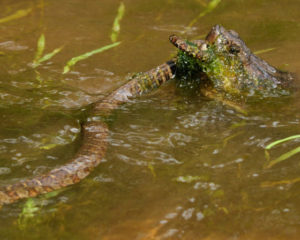
The surprise reptilian clash held the colorful snake in close contrast to the turtle’s head. The turtle’s mouth was more of a razor edged compact beak, a creamy tan with fine vertical black lines. The round orb of its bulging eye and dark pupil were the only recognizable shapes against a pattern of dull and dark brown irregular patches that covered the turtle’s head. The black pupil was surrounded by three thick, dark brown streaks radiating out at 3, 6 and 9 o’clock positions, a pattern quite like a style of crosshair seen in some rifle scopes.
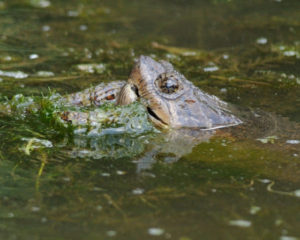
The painted water snake, alias, northern water snake, by its nature, was a linear billboard showcasing a recurring pattern of a variety of shades of tan and orange, and black, the pattern getting tighter and more compact near the tail. The snake must a have just shed, as its colors gleamed to a high shine, enhanced by the water.
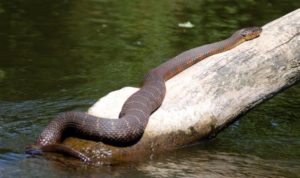
This is a painted/northern watersnake; the colors are more brilliant just after it sheds its skin.
This snake recently dined on some other good sized aquatic critter, now seen as the large bulge in the snake’s stomach.
The fight raged on for several minutes, coming to an abrupt end when my boat drifted closer to the combatants. The turtle became intimidated and released the snake, drama over, no evidence of what had just taken place except for some digital images. I imagine the education of both animals was advanced by their encounter.
A mile down river the scenery changed as the main current, hugging the up heaved, high, red shale cliff, was slowed by a gravelly shoal stretching across the river. Here, the high cliff disappeared back into the ground to give way to a woodsy landscape. The river narrowed and water became deeper. The tree tops reached across the river to give the impression of a leafy tunnel. This was a straight, short stretch that now opened up to allow the first river view of the Sourland Mountains. An island divided the river here, diverting more water to the right passage around a sharp bend, than to the left.
The island had a few small trees smothered in tall sun drenched, light colored grass that reached into the shallow water. Recent events had kept the water level far below normal and as a result, the delicate grass began to grow and prosper where it normally would not. The water level on this day was now raised and flooded the fine green grass.
Here, the river bed follows a deep, narrow cut, close to the right shore and obstructed with fallen trees. From the island to the cut, the river was impassably shallow. Coming around sharp bends on an intimate river usually holds the best surprises. Today was not a disappointment as a doe was standing in the water staring at me from 20 feet away.
There was little I could do keep still, as the narrow passage along the bank required some quick paddle strokes to avoid being grounded. That mandatory movement caused the doe to run off, seeming more annoyed than frightened. Behind her were two spotted fawns that splashed away through the shallow water and tender grass. The one fawn ran toward a second doe, keeping close to her heels. Alerted, the doe and fawn ran a few paces and stopped. They really were reluctant to end their mid day romp in the cool river. Water droplets flew in slow motion as the doe and fawn ran off two more times. The light green grass was finely detailed, while the same green scene reflected in the water, lost the detail, but kept the essence of the verdant color to make the foreground and background indistinguishable from each other. The two deer, resplendent in their red summer coats, the fawn, speckled white, complimented the green background.
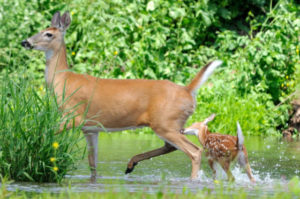
The water exploded from splashing hooves to energize the scene, as it stood in contrast to the reflective water. Raising her pure white tail, the doe provide an exclamation mark to the perfect image to represent high summer on the South Branch.
Author Joe Mish has been running wild in New Jersey since childhood when he found ways to escape his mother’s watchful eyes. He continues to trek the swamps, rivers and thickets seeking to share, with the residents and visitors, all of the state’s natural beauty hidden within full view. To read more of his writing and view more of his gorgeous photographs visit Winter Bear Rising, his wordpress blog. Joe’s series “Nature on the Raritan, Hidden in Plain View” runs monthly as part of the LRWP “Voices of the Watershed” series. Writing and photos used with permission from the author.
by Joseph Sapia
Gardening: In Helmetta, Monroe, and Jamesburg
2016, August 7, Sunday, to August 13, Saturday
The gardening and yard references are to my house in the section of Monroe between Helmetta and Jamesburg in South Middlesex County. My yard is in a Pine Barrens outlier on the Inner Coastal Plain, the soil is loamy, and my neighborhood is on the boundary of Gardening Zones 6b and 7a.
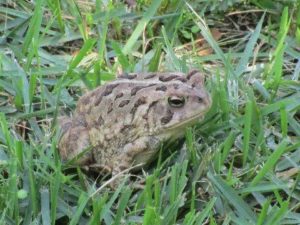
Fowler’s Toad
HARVESTING: Cucumbers. Picked a cantaloupe, but I should have waited. So, holding off on picking more cantaloupes.
TO HARVEST OR NOT TO HARVEST: My tomatoes are not moving – they are not growing and ripening, plants are dying. I think the wildlife has been getting to them….
THE LAWN: Because of work and the weather not cooperating on my days off (that is, either raining or threatening thunder storms with lightning), I got way behind on cutting the grass. So,…
CUTTING THE GRASS IN THE HEAT: I jumped on a sunny, day-off opportunity to cut the lawn – in 95 degrees with a heat index of 114 degrees. I wet my straw hat, stayed hydrated by drinking plenty of water, and took breaks. It was a grind for this old (59) boy. Three wet T-shirts and one fear-of-lightning break later, I finished the backyard.
CUTTING DOWN THE GARDEN: I mowed over the area where the lettuce had been planted – and, now, considering planting a late crop of lettuce. I also mowed down for the most part the done-producing corn stalks.
WILDLIFE IN THE YARD: The raccoons continue to topple the bird-feeder if I do not get it in the garage early enough at night. And I came across a Fowler’s toad — easily identifiable by the several warts in the splotches –while cutting the lawn. And, yes, the toad urinated when I caught him. I let him go in one of the high-grass wildlife patches I keep in the yard. (Photo of the Fowler’s toad.)
ROSE THORN IN MY FOOT: Despite wearing sneakers, I got a rose thorn in the big-toe area of my right foot. Pulled that sucker out fully. Not like the thorn or whatever that I have/had stuck in the ball of my left foot for about three weeks. Just keeping an eye on it, making sure it is not infected, waiting for it to work itself out.
MOSQUITOES: NJ has had at least three cases of West Nile virus in humans – one in Camden County, according to the state; two in Monmouth County (Atlantic Highlands and the Spring Lake area), according to the county. I checked a barrel I keep with a combination of rain, gray water, and de-humidifier water and found mosquito larvae in it. So, I emptied some of it and put a top on the barrel of the remainder. Interestingly, I cannot recall one mosquito bite this season.
— Joseph Sapia
2016, August 13, Saturday,
Joe Sapia, 59, has lived his whole life in Monroe. He is, among other things, a Pine Barrens naturalist and a vegetable gardener. He gardens the same backyard plot as did his Italian-American father, Joe Sr., and his Polish maternal grandmother, Annie Poznanski Onda. Both are inspirations for his vegetable gardening. And he draws inspiration on the local Pine Barrens from his mother, Sophie Onda Sapia, who lived her whole life in the local Pines, and his grandmother.
Call for Proposals
coLAB Arts and the Lower Raritan Watershed Partnership are seeking submissions for proposals for new works of found object sculpture using items of trash collected from the Lower Raritan Watershed (The Raritan River and its tributaries).
What is the Watershed Sculpture Project?
This project is the result of a partnership between coLAB Arts and the Lower Raritan Watershed Partnership (LRWP). Our organizations seek to create awareness of the maturing visual arts scene in the Lower Raritan Watershed as well as the need for community involvement to restore local environmental health. coLAB Arts and LRWP coordinate volunteer clean-ups of area streams and from the refuse collected we identify objects to give to commissioned artists who then create original sculptures for public display.
2016 Commission Theme
In 2016 The Watershed Sculpture Project will work with the theme of “Frames.” We ask that all proposals incorporate this idea literally in the creation of a sculpture that frames the landscape and can be installed semi permanently along the Raritan River Waterfront at Boyd Park in New Brunswick. Additionally, we hope the work “frames” a conversation on how viewers can interact in more positive ways with New Jersey’s largest major waterway.

Sample image of framing landscape concept
2016 Commission Fee
$150
Materials
Examples of previous year’s materials may be found here: http://www.colab-arts.org/watershedsculptureproject/ Materials sourced have included, plastic bottles, shopping carts, wood, children’s toys, broken ceramics and glass, etc. coLAB Arts and LRWP have stockpiled a small collection of usable materials from previous clean-ups but will also organize a 2016 clean-up toward the end of August 2016 based on interest from selected artists. Because of project goals we ask that artists be cognizant of making their projects entirely or almost entirely of collected clean-up items. In addition, we ask artists to consider not using toxic adhesives or paints.
Display Requirements
September 25 – Raritan River Festival, Boyd Park
October 1 – “Watershed Moment” event Boyd Park
Winter – Fall 2017 Watershed Gallery, Wellness Plaza, New Brunswick
All sculptures will be displayed for two major events one week apart in Boyd Park in New Brunswick. Final sculptures should be constructed to survive in the park semi-permanently during the fall months. All work will then also have a year-long display at our permanent lobby-style gallery space in the Wellness Center Plaza in New Brunswick.
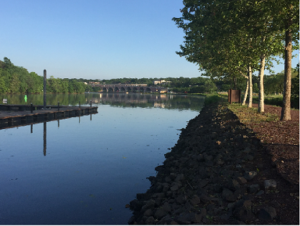
Boyd Park Waterfront in New Brunswick, NJ
Contact
Please submit a simple proposal idea by August 15 2016 to:
John Keller
Director of Education and Outreach
Curator, Watershed Sculpture Project
jpkeller@colab-arts.org
(732) 718 – 7614
With support from the EPA Urban Waters Federal Partnership and from New Jersey’s Watershed Institute, from July 26-28 the LRWP joined dozens of other urban waters communities from around the United States and Puerto Rico for the 2016 Urban Waters National Training Workshop in Washington, DC.
The Urban Waters Federal Partnership, now in its 4th year, is an innovative union of 14 federal agencies working to provide integrated support to communities – particularly under-served and economically distressed communities – as they transform their local urban waters into treasured centerpieces for community revitalization.
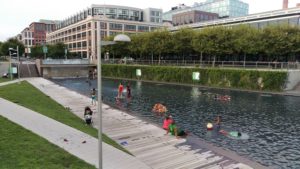
Splash pool along DC’s Anacostia River – image, Heather Fenyk
At the Training Workshop communities told stories of how their urban rivers, streams, forests and wetlands are polluted, degraded or inaccessible. But they also highlighted examples of how they are working to measure the relationship between clean, safe and accessible waters environments and improved public health, stronger local economies and lower crime rates.
Mayors talked about making clean water a part of every conversation, and about turning to the water to revive civic life. Volunteer water quality monitors talked about the new perspectives gained by “discovering” regional landscapes through their work. And community organizers showed how process is as important as the final product in terms of sustaining the work to clean up our rivers and streams.
We also had the chance to tour areas like DC’s Anacostia River – a slow-moving diurnal water body dotted with CSOs – to be inspired by how creative landscape design integrates CSO infrastructure, safe river access and play spaces to formerly derelict sites.
As groups from around the country shared how deeper connections to our local water bodies can bring community energy that will lead to healthier urban waters, improved public health, strengthened local businesses, and new jobs it became clear that our work in the Lower Raritan Watershed contributes to an important national movement to clean up our urban rivers, streams and watersheds.
Photos and Writing by Joseph Sapia
The gardening and yard references are to my house in the section of Monroe between Helmetta and Jamesburg in South Middlesex County. My yard is in a Pine Barrens outlier on the Inner Coastal Plain, the soil is loamy, on the boundary of Gardening Zones 6b and 7a.
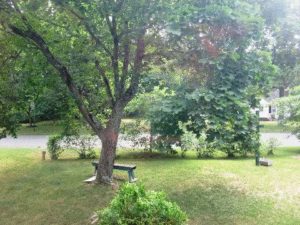
Front yard
EARLY MORNING HOURS IN THE GARDEN: On Wednesday, I got up around 5:20 a.m. for an early day at work and had the garden half-watered by 6 a.m. I watched the sky change color, listened to a crow, and watched a great blue heron fly by. Peace!
HARVESTING LETTUCE: I dug out 2 heads of lettuce and brought them to work for distribution. Worried the lettuce would start bolting in the heat wave, I was looking to use it up. It turns out there was no need to worry. The lettuce is still producing well, despite the heat.
LAST YEAR’S SUNFLOWERS: I had forgot I have last year’s sunflower crop hanging from the ceiling and drying in the garage. Well, I remembered and began spreading the seeds for the birds, squirrels, and any other wildlife that eats them.
BEARS ON THE MOVE: Various roaming black bear reports have come in over the last week or so: in South Brunswick and Milltown, for example. Stay clear and all should be OK.
FLOWERS IN THE VEGETABLE GARDEN: Cantaloupes, peas, and cucumbers are flowering, the sweet corn is in tassel, and a white flower is blooming. As for white flower, I am unsure if it is growing on its own, part of the pollinator seeds I threw down, or something else.
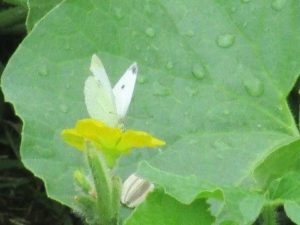
Cabbage White on Cantaloupe
“KNOCK OUT” ROSES: The “Knock Outs” seem to be doing something different this year — peaking, but retaining blooms, rather than losing all blooms until the next peak.

Knock Out Rose
AROUND THE YARD: Stinkhorn mushrooms are popping up.
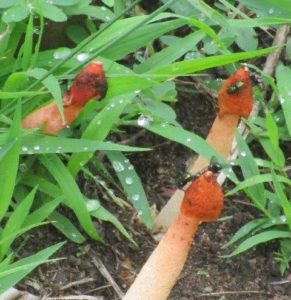
Flies on Stinkhorn Mushrooms
YARDWORK: Saturday’s thunderstorm forecast kept me from my planned trimming of the shrubs and hoeing the vegetable garden. The shrubs can wait, but I really need to attack the garden weeds on Sunday.
QUOTE OF THE WEEK: Friend Jimmy Krygier, a 3rd generation nurseryman of the 100-year Krygier’s Nursery on Cranbury Road just outside Helmetta, noted the perkiness of the vegetation as we were driving a backroad after the recent rains and he said something to the effect of, “The vegetation is smiling because of the rain. Even the weeds.”
DOWN THE SHORE: The clinging jellyfish, “Gonionemus vertens,” an invasive species indigenous to the Asian Pacific Ocean, has been found in the Shrewsbury River and Manasquan River recently. Their stings are very hurtful and could require hospitalization. They are not expected in Raritan Bay or in the Atlantic Ocean.
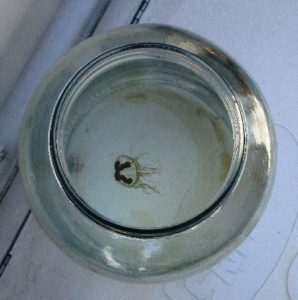
Clinging jellyfish from the Shrewsbury River at Monmouth Beach
SOMETHING TO WATCH FOR: In the local Pine Barrens, watch for the beginning of the “fall” foliage colors from around July 15 to July 30.
Joe Sapia, 59, has lived his whole life in Monroe. He is, among other things, a Pine Barrens naturalist and a vegetable gardener. He gardens the same backyard plot as did his Italian-American father, Joe Sr., and his Polish maternal grandmother, Annie Poznanski Onda. Both are inspirations for his vegetable gardening. And he draws inspiration on the local Pine Barrens from his mother, Sophie Onda Sapia, who lived her whole life in the local Pines, and his grandmother.
48 N.J.R. 1349(a)
NEW JERSEY REGISTER
Copyright © 2016 by the New Jersey Office of Administrative Law
VOLUME 48, ISSUE 13
ISSUE DATE: JULY 5, 2016
RULE PROPOSALS
ENVIRONMENTAL PROTECTION
LAND USE MANAGEMENT
48 N.J.R. 1349(a)
Proposed Amendments: N.J.A.C. 7:7-6.4, 15.2 and 25.1; 7:7A-11.1; and 7:13-1.2, 6.7, 7.8 through 7.12, 7.29, 7.56, 7.58, 7.61, 8.5, 8.6, 8.8, 8.13, 9.5, 9.6, 9.8 through 9.10, 11.2, 12.5, 12.14, 13.1, 13.2, 13.6, 13.7, 13.8, 13.14 through 13.20, and 20.1
Proposed New Rule: N.J.A.C. 7:13-13.4
Click here to view Interested Persons Statement
Flood Hazard Area Control Act Rules
Coastal Zone Management Rules
Notice of Rescheduling of Public Hearing
Freshwater Wetlands Protection Act Rules
Take notice that the Department of Environmental Protection (Department) is rescheduling the public hearing on proposed amendments and new rules in the Flood Hazard Area Control Act (FHACA) Rules, N.J.A.C. 7:13, Coastal Zone Management (CZM) Rules, N.J.A.C. 7:7, and Freshwater Wetlands Protection Act Rules, N.J.A.C. 7:7A, PRN 2016-084. The proposed amendments and new rule were published in the New Jersey Register on June 20, 2016 at 48 N.J.R. 1014(a). The Department has rescheduled the hearing date as indicated below.
A copy of the notice of proposal is available at http://www.nj.gov/dep/rules and from LexisNexis free public access to the New Jersey Register, www.lexisnexis.com/njoal.
A public hearing concerning the notice of proposal is scheduled as follows:
Friday, July 22, 2016, at 10:00 A.M.
NJ Department of Environmental Protection
Public Hearing Room
401 East State Street
Trenton, NJ 08625
Submit comments by August 19, 2016, electronically at http://www.nj.gov/dep/rules/comments. The Department of Environmental Protection (Department) encourages electronic submittal of comments. In the alternative, comments may be submitted on paper to:
Gary J. Brower, Esq.
ATTN: DEP Docket No. 05-16-05
NJ Department of Environmental Protection
Office of Legal Affairs
Mail Code 401-04L
[page=1350] 401 East State Street, 7th Floor
PO Box 402
Trenton, NJ 08625-0402
In May, Alison M. Jones, Executive Director of our international partner organization No Water No Life, gave a talk in Tewksbury Twp. on the upstream-downstream issues of the Raritan Basin. Alison writes: “The audience was surprised – and then concerned – about the issues faced in the Lower Raritan and that some of the problems flowed down from the Upper Raritan.” After hearing Alison speak, one member of the audience was inspired to write an article for The Bernardsville News comparing the upstream-downstream disconnect in the Raritan Basin to the problems that led to Flint, Michigan’s drinking water debacle.
As in Michigan, in New Jersey we also face a state government willing to accept the public health risks of ignoring – and even compromising – necessary drinking water protections. The Christie administration has put new regulations into effect that will loosen the state’s clean water rules, opening up close to 400,000 acres of sensitive lands to development. While maintaining the integrity of upstream lands is clearly important for communities at higher elevations, the new regulations will have especially dire public health impacts on the state’s historically impaired and poorer downstream areas including the Lower Raritan and Raritan Bay. By opening up upstream lands to development, our downstream areas face compromised drinking water supplies, intensification of flooding, and increased water contamination associated with stormwater flows.
Senator Bob Smith, sponsor of Bill SCR66 that would invalidate Christie’s revisions to the Flood Hazard Control Act rules, has successfully pushed his bill through the Assembly and Senate Committees. There is significant support in the Senate for the bill, including from former Governor Tom Kean, the final hurdle is for Senate President Stephen Sweeney to post the bill to a vote in the full Senate today.
It is not news to our Lower Raritan communities that water, and all attendant pollution, runs downhill. The daily work in our downstream areas must address the clean-up of not only legacy industrial contamination but also non-point-source pollutants that are carried from upstream. The LRWP has been part of a statewide campaign to support Smith’s bill and to encourage Sweeney to post this bill for a vote in Senate, but successfully addressing historic and ongoing threats to the health of our downstream areas will require new and ongoing forms of regional cooperation. Clean drinking water and the health of our communities is at stake.
Photos and Writing by Joseph Sapia
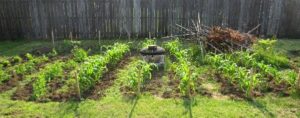
GARDEN AND AFIELD
2016, June 19, Sunday, to 2016, June 25, Saturday
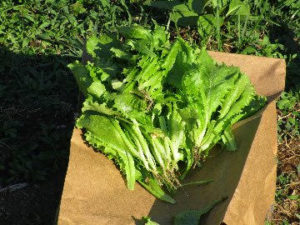
Lettuce
HARVESTING FROM THE GARDEN: I began picking lettuce, harvesting it leaf by leaf, rather than by the head, so the plant keeps producing. (In my haste, I pulled out too much leaf. So, next time, will clip them, saving the plant.) Then, I either munch on the leaf right there in the garden or take it inside for a sandwich.
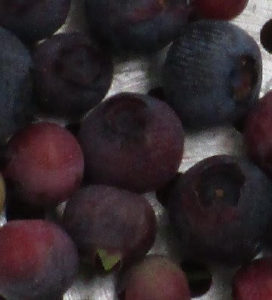
Wild blueberries
HARVESTING FROM THE LOCAL PINE BARRENS: Blueberries are ripening. I picked some the other day and mixed them into a cup of yogurt.
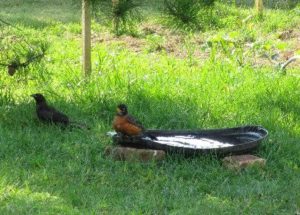
Bird bath
BIRD BATH: I keep a bird bath filled with water at ground level. Birds not only “bathe” in it, but birds and other animals drink from it.
WILDLIFE IN THE YARD: The raccoons are still taking advantage of the sunflower kernels in the bird-feeder. And, one evening, I saw a huge skunk passing by.
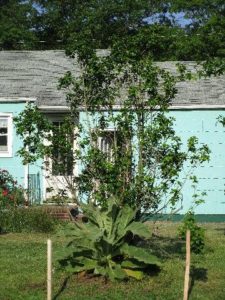
Mullein in front of the American holly
WEEDS IN MY YARD: As I have mentioned, I leave many weeds growing to see what they develop into. Well, I have a huge mullein taking over my American holly in my backyard. In the front yard, I have pokeweed growing.
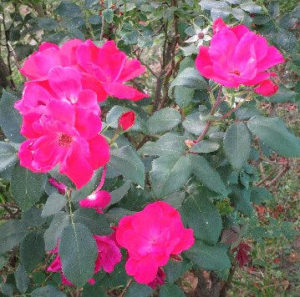
“Knock Out” roses
“KNOCK OUT” ROSES: Surprisingly, the first bloom of “Knock Out” roses continues.

Fungi in the backyard
FUNGUS, IN YARD AND WOODS: Fungi growing in my backyard and some in the local Pine Barrens.
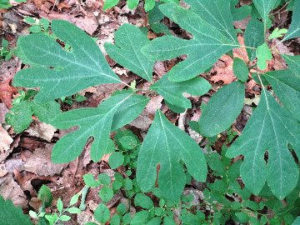
Sassafras with its three styles of leaves
SASSAFRAS IN THE LOCAL PINE BARRENS: Sassafras trees can have three leaf patterns on the same tree: a two-prong mitt, three-prong, and oval. I found an aberration this week, one with five prongs.
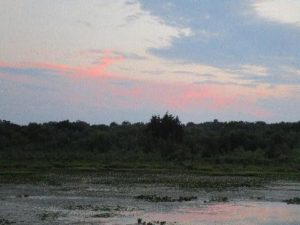
Helmetta Pond at sunset
Joe Sapia has been a professional journalist since the 1970s. He also is a writing teacher, folk artist, vegetable gardener, Pine Barrens woodsman, Helmetta area historian, and Jeep driver, along with being Marquette University Jesuit-educated..
Born in 1956, Joe is a lifelong resident of Central Jersey, where his family — through his maternal side, the old Polish and Slovak workers of the George W. Helme Snuff Mill in Helmetta — has lived since about 1900. He is a voice of the land and Old Jersey ways.
NJ DEPARTMENT of ENVIRONMENTAL PROTECTION
LAND USE MANAGEMENT
Notice of Rule Proposal
Flood Hazard Area Control Act Rules, N.J.A.C. 7:13
Coastal Zone Management Rules, N.J.A.C. 7:7
Freshwater Wetlands Protection Act Rules, N.J.A.C. 7:7A
PUBLIC NOTICE
Take notice that the New Jersey Department of Environmental Protection (Department) is proposing amendments and new rules in the Flood Hazard Area Control Act (FHACA) Rules, N.J.A.C. 7:13, Coastal Zone Management (CZM) Rules, N.J.A.C. 7:7 and Freshwater Wetlands Protection Act Rules, N.J.A.C. 7:7A. The proposed amendments and new rules fall into the following six categories: improvements to riparian zone protections; improving consistency of the FHACA Rules with the Uniform Construction Code (UCC) and National Flood Insurance Program; improving consistency between the FHACA Rules and CZM Rules; facilitation of environmentally beneficial activities; clarification that permits-by-rule, general permits-by-certification, and general permits may not be used for activities qualifying as “major development;” and changes regarding the fees associated with the review of stormwater calculations.
The proposal is scheduled to be published in the New Jersey Register dated June 20, 2016. A copy of the proposal is available athttp://www.nj.gov/dep/rules/proposals/20160620a.pdf and from LexisNexis free public access to the New Jersey Register,www.lexisnexis.com/njoal.
A public hearing concerning the proposal is scheduled. The public hearing, as indicated in a notice of rescheduling of public hearing to be published in the July 5, 2016 New Jersey Register, is scheduled as follows:
Friday, July 22, 2016 at 10:00 A.M.
NJ Department of Environmental Protection
Public Hearing Room
401 East State Street
Trenton, NJ 08625
Article and photos by Joe Mish

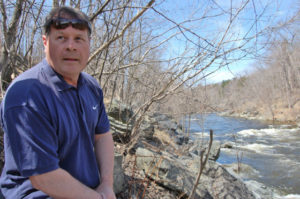
If shadows and footprints were indelible and double exposures across time possible, you might be able to see Henry David Thoreau standing next to Joe on the shore of the Raritan River in New Jersey and the rocky streamside of the Kenduskeag in Maine. Each contemplating the wonder of nature where others might not see anything of value or beauty.
I always lived within sight of where the Raritan flows, the river being a reference point in my life. So embodied in my psyche is the river, that when at the recent 8th Sustainable Raritan River Conference at Rutgers, mention of the words, ‘Raritan River’ by one of the academic speakers felt as if it was me he was talking about. In reality the cumulative agenda was revealing the natural treasures hidden in plain view that I had discovered as a wayward youth and fondled as an adult through a newspaper column and photos.
The Raritan River basin drains about 1,100 square miles of New Jersey. The main Raritan River and bay is the summation of the North and South branches and their tributaries. I hunted ducks and trapped muskrats on the tidal creeks in season and for the rest of the year roamed the area exploring its history, geology, flora and fauna.
My interest in local nature only grew, as the gravitational pull of curiosity generated by this region’s unique natural diversity, drew me deeper into science and fostered an appreciation of its inherent beauty.
Years later I moved up river along the South Branch, fascinated by the thought of the river system as a watery highway. I paddled throughout the year and twice to Raritan Bay.
Eventually the South Branch became a training venue for the Kenduskeag Stream Canoe Race in Bangor Maine. Starting in January each year I would paddle an 11 mile stretch of river several times a week to get in shape for the 16.5 mile canoe race in Maine, which is held in mid April. I ran that race for 20 years, 18 straight years without interruption. Who knew this connection held a significant piece of a puzzle I didn’t know I was putting together.
At some point along the way, when doing research on the Raritan, I came across a history of Perth Amboy, a town located at the mouth of the Raritan River. Its list of astounding historic firsts also included a who’s who of famous visitors; Henry David Thoreau’s name was casually noted. That was very interesting, though just an isolated bit of information.
It was when I began to participate in the Maine canoe race that a coincidence hit me like a lightning bolt. Thoreau’s name came up again, this time linked to the Kenduskeag Stream and Bangor. The lights started to flash, Perth Amboy and Bangor, two river towns prominent in my life.
For those who don’t know, David Henry Thoreau, better known as Henry David Thoreau, or HDT, by his followers, is relevant today for his writings, diaries and environmental awareness. Among his best known works are ‘Walden’, ‘Civil Disobedience’, ‘Walking’ and ‘The Maine Woods’. An abolitionist and anarchist closely associated with Ralph Waldo Emerson, Louisa May Alcott and a lesser known association with Marcus Spring and Eagleswood.
Eagleswood was a utopian society established in Perth Amboy and the focus of Thoreau’s month long visit to New Jersey in October through November 1856. The visit was facilitated by Louisa May Alcott’s father, Bronson Alcott. Thoreau was hired to lecture the Eagleswood society and do a land survey.
I began to research Thoreau, Eagleswood and the Bangor Connection as I seemed to be a kindred spirit of Thoreau, as assessed by some that know me.
If footprints and shadows were indelible, HDT and I would have been physically bumping into each other. I wasn’t following in Henry’s footsteps as much as I was crossing them.
There is a great article by, Wayne Dilts, a New Jersey resident and member of the Thoreau Society who describes Thoreau’s NJ visit. Wayne’s article is found in the Thoreau Reader and titled, “Thoreau’s New Jersey Connection”; http://thoreau.eserver.org/jersey.html
Reviewing other sources for Henry’s actual diary entries for October 25th through mid November 1856 I discovered Thoreau had wandered about 2 miles west of Eagleswood, which placed him directly in the wilds I once roamed.
“Nov 2nd – Took a walk 2 miles W of Eagleswood – the quercus palustris or pin oak, very common there…”
Thoreau goes on to describe the plants, soil and topography he observed. One entry that really hits home are his words; “I see apparently the sea side goldenrod lingering still by the Raritan River”
This entry stunned me.
Here was a revered philosopher and man of nature, who transcended Walden Pond and Massachusetts to be embraced by the world and relevant for more than a century and a half to the environmental movement, said the magic word, “Raritan River”. This was the first time I experienced what I described earlier at the Sustainable River Conference, an independent discovery of our natural treasures hidden in plain view. My secret world exposed a century and half ago and still viable today.
A further look into the Thoreau, Bangor and Kenduskeag connection, bought more surprises and mingling of footsteps and shadows.
Bangor was at the edge of civilization in Maine and served at the trailhead for Thoreau’s Maine Journey to Mount Katadin via the Penobscot River with his Indian guide, Joe. Thoreau was later to say Joe was one of just a couple of people he most admired.
Thoreau also had cousins in Maine who were friends of the Pratt family. One document I read, and cannot now find as a reference, mentioned Henry and his cousin being invited to dinner at the Pratts.
As it turns out, it was the Pratt family in Bangor who hosted me each April during the Kenduskeag stream canoe race. The connection between the Pratt families in Bangor, then and now, seems to have been lost, but the parallel experiences of two out of state visitors in Bangor are wild coincidence.
“…….the impetus for Thoreau’s interest in Bangor and the northern Maine woods were his cousins Rebecca Jane Billings and Mary Ann Thoreau Billings, and aunt Nancy (Thoreau) Billings, who lived in the Queen City.”
The shore along the lower Kenduskeag, where it empties into the Penobscot River in Bangor, also marks the finish line of the canoe race. Coincidentally there are two mandatory portages around the old flour mill dam and a natural ledge which forces racers to carry their boats along the same path Henry walked.
“During his travails to Bangor, Thoreau often hiked along the Kenduskeag Stream and noted the plant and flower life along its shores.”
http://bangorinfo.com/Focus/focus_kenduskeag_stream.html
Henry’s last word as he died on May 6th 1862 was ‘moose’. Coincidentally my last word as I left Maine, after an unsuccessful month long archery moose hunt, was ‘moose!’, followed closely by the guttural inflection, ‘grr’. I waited more than thirty years to get drawn in the Maine moose lottery and went home with a consolation prize of 15 pounds of moose meat from a sympathetic donor, knowing full well that was my last breath of a chance at a Maine moose.
As I was finally completing this article, which had been simmering for more than two years, a hummingbird, the first one I had seen this season, flew up to the window, where I sat and stared at me for several seconds before flying off. I took that as a sign Henry was nearby and impressed by the coincidence of our footsteps and shadows.
Author Joe Mish has been running wild in New Jersey since childhood when he found ways to escape his mother’s watchful eyes. He continues to trek the swamps, rivers and thickets seeking to share, with the residents and visitors, all of the state’s natural beauty hidden within full view. To read more of his writing and view more of his gorgeous photographs visit Winter Bear Rising, his wordpress blog. Joe’s series “Nature on the Raritan, Hidden in Plain View” runs monthly as part of the LRWP “Voices of the Watershed” series. Writing and photos used with permission from the author.

























